#Nanosensors
Text
Using a new technology developed at MIT, diagnosing lung cancer could become as easy as inhaling nanoparticle sensors and then taking a urine test that reveals whether a tumor is present.
The new diagnostic is based on nanosensors that can be delivered by an inhaler or a nebulizer. If the sensors encounter cancer-linked proteins in the lungs, they produce a signal that accumulates in the urine, where it can be detected with a simple paper test strip.
0 notes
Text
Nanosensors for Water Quality Monitoring
Nanosensors for Water Quality Monitoring

View On WordPress
0 notes
Text
#graphene#Dopamine_sensor#electrochemistry#sensor#Electrochemical_sensor#Nanosensor#Biosensor#Dopamine#Voltamammetry
7 notes
·
View notes
Text
In this study, graphene oxide was electrochemically deposited and reduced on a graphite sheet. The electrode surface morphology was studied by scanning electron microscopy. The performance of the modified electrode in detecting dopamine was investigated. The results indicate that the electrodeposition of reduced graphene oxide onto the electrode surface increases the dopamine oxidation current, decreases the overpotential, and reduces the charge transfer resistance. The efficiency of dopamine detection by this modified electrode was evaluated using cyclic voltammetry, differential pulse voltammetry, and electrochemical impedance spectroscopy. The effects of ...
#chemistry#dopamine neurotransmitter#nanosensor#materials science#Ananlytical_chemistry#nanotechnology#sensor#sensory
1 note
·
View note
Text
Global Nanosensors Market: A Strategic Outlook for the Next Decade (2023-2033)
The global Nanosensors Market is experiencing robust growth, with a valuation of approximately US$ 759.4 million in 2023. Projected to achieve a staggering CAGR of 7.1%, it is anticipated that the market will reach a remarkable US$ 1,512.5 million by the year 2033. These insights emerge from an in-depth analysis conducted by Future Market Insights.
The predominant share of market revenue is derived from Biosensors, projected to witness a CAGR of 6.6% by 2033. Notably, Healthcare emerges as the leading application sector with a projected CAGR of 6.3% in the forecast period.
Request a Report Sample :
https://www.futuremarketinsights.com/reports/sample/rep-gb-15594
Key Takeaways
The global Nanosensors Market is on a remarkable growth trajectory, with a projected valuation of US$ 1,512.5 million by 2033.
Nanosensors’ widespread application in healthcare, electronics, manufacturing, and aerospace is a key driver of market expansion.
The United States plays a pivotal role in the market’s growth, driven by a CAGR of 10.5% and substantial research funding.
United States: A Pinnacle Market for Nanosensors
The United States emerges as a pivotal market for nanosensors, demonstrating an impressive Compound Annual Growth Rate (CAGR) of 10.5%. This growth is accompanied by an absolute dollar opportunity of US$ 200.5 million, resulting in a forecasted market size of US$ 759.4 million at a CAGR of 7.7%. The surge in demand in the United States is predominantly driven by substantial research funding and grants allocation, further fostering the market’s expansion.
Key Developments Driving Growth
In September 2020, Nanobiofab proudly announced the award of a significant grant, amounting to US$ 250,000, from the Defence Health Agency’s SBIR program. This grant is earmarked for advanced research, particularly an Inkjet-assisted nano-printing sensing platform.
The National Institute of Food and Science oversees four pivotal grant programs dedicated to funding nanotechnology-related projects. Of particular concern is their utility in detecting contaminants such as pathogens and allergens.
August 2021 marked a significant milestone when the National Institutes of Health’s National Institute of General Medical Sciences allocated US$ 1.96 million in funding to a biomedical engineer at the City College of New York. This funding, awarded as part of the Maximizing Investigator’s Research Award for Early Stage Investigators program (MIRA ESI), is dedicated to the development of innovative fluorescent Nanosensors for the study of cytokine signaling in chronic diseases.
Get More Information on this Report :
https://www.futuremarketinsights.com/reports/nanosensors-market
Market Snapshot
In 2023, the global Nanosensors Market is valued at approximately US$ 759.4 million, with a projected CAGR of 7.1%, set to reach US$ 1,512.5 million by 2033.
Drivers and Opportunities
The extensive application of Nanosensors across various sectors and increased funding for research and production by authorities are primary drivers of market growth.
Competitive Landscape-Regional Trends
The United States takes center stage with a CAGR of 10.5% and an absolute dollar opportunity of US$ 200.5 million, propelling the Nanosensors Market to a forecasted size of US$ 759.4 million at a CAGR of 7.7%.
Restraints
While the Nanosensors Market is experiencing substantial growth, challenges related to regulatory frameworks and quality control may hinder its expansion.
Region-wise Insights – Category-wise Insights
The United States dominates the Nanosensors Market, exhibiting robust growth due to significant research funding and grants allocation.
Request for Customization:
https://www.futuremarketinsights.com/customization-available/rep-gb-15594
Key Segments Covered in Nanosensors Industry Survey
By Type :
Chemical Nanosensors
Optical Nanosensors
Physical Nanosensors
Biosensor
Others
By Application :
Electronics
Chemical Manufacturing
Energy
Aerospace and Defence
Healthcare,
Others
By Technology :
Molecular Self Assembly
Top-Down Assembly
Bottom-Up Assembly
By Region :
North America
Latin America
Europe
Asia Pacific
Middle East & Africa
0 notes
Text
Nano-sensor detects pesticides on fruit in minutes -- ScienceDaily
Nano-sensor detects pesticides on fruit in minutes — ScienceDaily
Researchers at Karolinska Institutet in Sweden have developed a tiny sensor for detecting pesticides on fruit in just a few minutes. The technique, described as a proof-of-concept in a paper in the journal Advanced Science, uses flame-sprayed nanoparticles made from silver to increase the signal of chemicals. While still at an early stage, the researchers hope these nano-sensors could help…
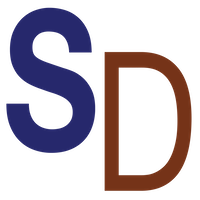
View On WordPress
#Agriculture and Food; Food and Agriculture; Food; Organic; Detectors; Nanotechnology; Wearable Technology; Materials Science#Detects#fruit#minutes#Nanosensor#pesticides#ScienceDaily
0 notes
Text
Purr For Mommy
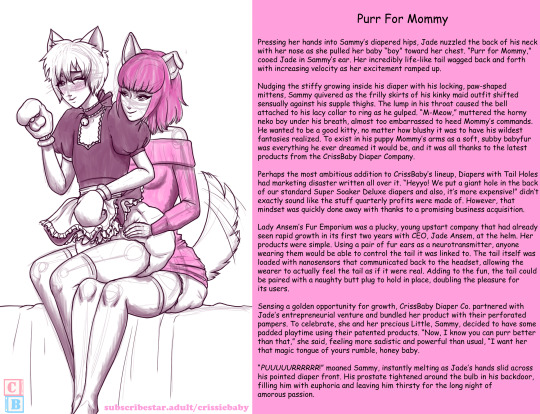
Pressing her hands into Sammy’s diapered hips, Jade nuzzled the back of his neck with her nose as she pulled her baby “boy” toward her chest. “Purr for Mommy,” cooed Jade in Sammy’s ear. Her incredibly life-like tail wagged back and forth with increasing velocity as her excitement ramped up.
Nudging the stiffy growing inside his diaper with his locking, paw-shaped mittens, Sammy quivered as the frilly skirts of his kinky maid outfit shifted sensually against his supple thighs. The lump in his throat caused the bell attached to his lacy collar to ring as he gulped. “M-Meow,” muttered the horny neko boy under his breath, almost too embarrassed to heed Mommy’s commands. He wanted to be a good kitty, no matter how blushy it was to have his wildest fantasies realized. To exist in his puppy Mommy’s arms as a soft, subby babyfur was everything he ever dreamed it would be, and it was all thanks to the latest products from the CrissBaby Diaper Company.
Perhaps the most ambitious addition to CrissBaby’s lineup, Diapers with Tail Holes had marketing disaster written all over it. “Heyyo! We put a giant hole in the back of our standard Super Soaker Deluxe diapers and also, it’s more expensive!” didn’t exactly sound like the stuff quarterly profits were made of. However, that mindset was quickly done away with thanks to a promising business acquisition.
Lady Ansem’s Fur Emporium was a plucky, young upstart company that had already seen rapid growth in its first two years with CEO, Jade Ansem, at the helm. Her products were simple. Using a pair of fur ears as a neurotransmitter, anyone wearing them would be able to control the tail it was linked to. The tail itself was loaded with nanosensors that communicated back to the headset, allowing the wearer to actually feel the tail as if it were real. Adding to the fun, the tail could be paired with a naughty butt plug to hold in place, doubling the pleasure for its users.
Sensing a golden opportunity for growth, CrissBaby Diaper Co. partnered with Jade’s entrepreneurial venture and bundled her product with their perforated pampers. To celebrate, she and her precious Little, Sammy, decided to have some padded playtime using their patented products. “Now, I know you can purr better than that,” she said, feeling more sadistic and powerful than usual, “I want her that magic tongue of yours rumble, honey baby.
“PUUUUURRRRRR!” moaned Sammy, instantly melting as Jade’s hands slid across his pointed diaper front. His prostate tightened around the bulb in his backdoor, filling him with euphoria and leaving him thirsty for the long night of amorous passion.
💜 Artwork By CodiBaby 💜
💕 Story By CrissieBaby💕
SubscribeStar: subscribestar.adult/crissiebaby
pixivFANBOX: crissiebaby.fanbox.cc
All CB Links: linktr.ee/crissiebaby
-------------------------------------------------------------
Special Thanks to Our CrissBaby Diaper Company Investors:
BlushyBen
DD
JFN
Joshy
LittlePissy
Nike
PrincessKittenLizzi
SissyDina
Strawberry
Sweetsamantharebecca
& Three Anonymous Investors
#diaper art#diaper stories#crissiebaby#little space#ab/dl#ab/dl stories#ab/dl art#diaper humiliation#crissbabydiaperco#ab/dl girl#codibaby#ab/dl caption#diaper captions#humiliation sissy#wetting diaper#dirty diaper#diaper messy#agepl@y#ab/dl community#sissi femboi#sissybaby#diaper sissy#sissy story#diaper fur#baby fur#diaperfur#babyfur#petpl@y#nekoboy#puppy gf
53 notes
·
View notes
Text

Single drop of ethanol to revolutionize nanosensor manufacture
Macquarie University engineers have developed a new technique to make the manufacture of nanosensors far less carbon-intensive, much cheaper, more efficient, and more versatile, substantially improving a key process in this trillion-dollar global industry.
The team has found a way to treat each sensor using a single drop of ethanol instead of the conventional process that involves heating materials to high temperatures.
Their research, published in Advanced Functional Materials, is titled, 'Capillary-driven self-assembled microclusters for highly performing UV detectors.'
"Nanosensors are usually made up of billions of nanoparticles deposited onto a small sensor surface—but most of these sensors don't work when first fabricated," says corresponding author Associate Professor Noushin Nasiri, head of the Nanotech Laboratory at Macquarie University's School of Engineering.
Read more.
#Materials Science#Science#Ethanol#Nanotechnology#Sensors#Materials processing#Capillary action#Macquarie University
33 notes
·
View notes
Text
Macquarie University engineers have developed a new technique to make the manufacture of nanosensors far less carbon-intensive, much cheaper, more efficient, and more versatile, substantially improving a key process in this trillion-dollar global industry.
8 notes
·
View notes
Text
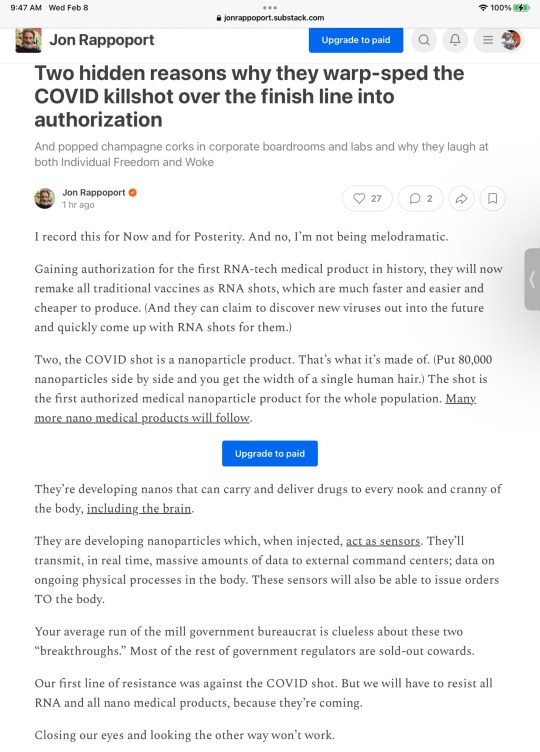
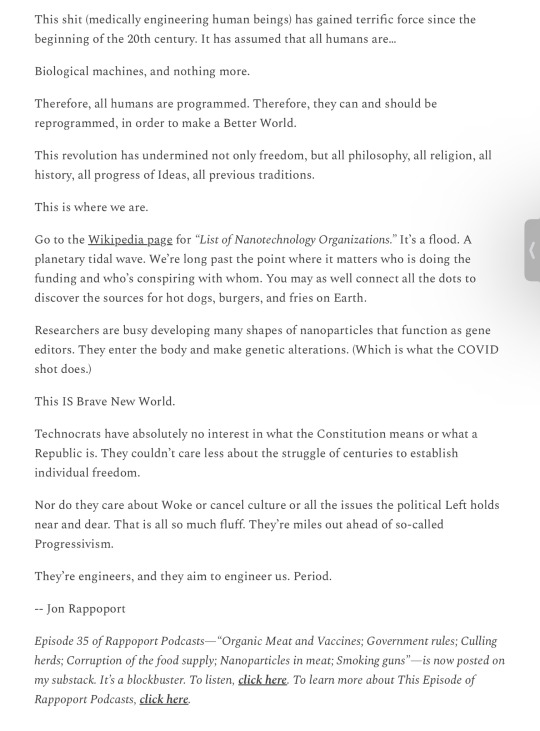
#everything is fucking managed#war on humanity#unquestioning obedience to celebrities bureaucrats and mass media#jon rappoport#biolabs#mrna#nanotechnology#nanobots#war bots#quantum dots
9 notes
·
View notes
Text
The Jerusalem Post has partnered with ExitValley, a digital platform that enables anyone to invest in Israel's start-up ecosystem and share in its success. In this article, we are pleased to introduce NanoVation-GS, an Israeli company that has developed a first-of-its-kind nanosensor-based technology for monitoring and managing chronic respiratory conditions at home or hospitals while reducing hospitalizations.
The patented technology was discovered at the Technion and is undergoing clinical trials in Israel and the EU. "The technology enables surveillance and early identification of changes in the patient's condition. In addition to reducing hospitalizations, it is also expected to reduce their duration", says the company's CEO and co-founder, Dr. Gregory Shuster, Ph.D.
NanoVation-GS has developed a unique technology for monitoring patients with chronic lung diseases, with an emphasis on obstructive diseases such as COPD - Chronic Obstructive Pulmonary Disease, which enables early detection of worsening of symptoms and helps reduce prolonged and frequent hospitalizations by allowing the patient to receive appropriate early treatment. “The device is designed to measure important respiratory parameters without any discomfort or effort needed by the patient,” says Dr. Shuster.

The development is based on advanced nanosensor technology, which for the first time allows accurate monitoring of changes in respiratory function without any discomfort or effort from the patient, and is particularly sensitive to fluctuations and changes in several critical respiratory parameters. "One of the things we identified was the gap in technologies related to respiratory monitoring. When you look at monitoring in cardiology, for example, there are much broader tools than in respiratory monitoring,” Dr. Shuster explains.
The solution provides the ability to manage chronic respiratory diseases via the cloud, allowing doctors to review data from any location, during hospitalization, and during the follow-up period at home, which also enables the creation of "big data"-bases of all relevant information. “The system is simple to use at home without any need for professional assistance or in a clinical environment. It operates in a non-invasive method, measures normal and effortless breathing, and uses exclusive biomarkers which were identified by the company's technology,” Dr. Shuster adds.
“The system is simple to use at home without any need for professional assistance or in a clinical environment”.
NanoVation-GS was founded at the Technion by a leading experienced team, including Dr. Shuster- founder and CEO and senior researcher in nanomaterials and materials engineering, and Prof. Hossam Haick, founder and CSO, a leading researcher and expert in nanotechnology. The company has an exclusive license for its first patent from the Technion and two additional patents owned by the company, which are in the registration phase.
NanoVation-GS has been granted a prestigious development grant by the European Innovation Council (EIC), which only supports start-ups identified as companies with a significant impact and groundbreaking technology. In addition, the company has previously received grants from the Israel Innovation Authority. "Breathing monitoring technologies today can be divided into two groups,” says Dr. Shuster. "One is the technologies that measure normal breathing, which are not invasive or annoying to the patient, but the data collected is limited to the parameter of breathing rate only.
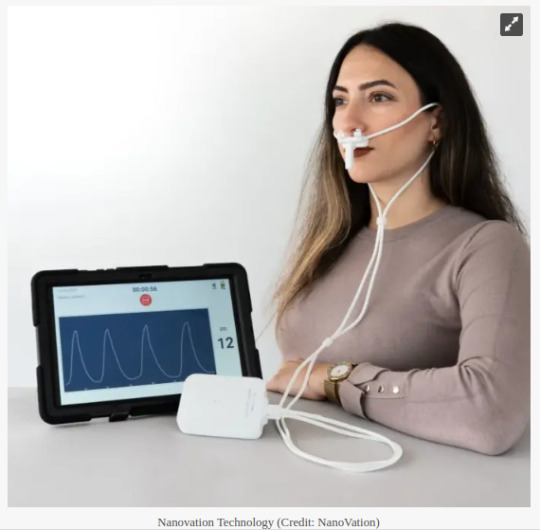
“The second group provides a series of respiratory parameters, but it requires the patient to perform certain breathing maneuvers. This is a complicated test for the patient to perform at home. It is bothersome, unpleasant for the patient, and the doctor who receives the data cannot know whether the test was performed properly, because he did not see the patient do it.
“What we do is combine the benefits of these two worlds," says Dr. Shuster. "On the one hand, our measurement takes a few minutes, during which the patient puts on the sensor and does nothing extra. On the other hand, the data we extract provides a series of respiratory parameters, which are very relevant to changes in the disease condition. All this in one simple test, which can also be done routinely at home. The patient cannot get an incorrect measurement, because all he has to do is breathe naturally.”
The company's SenseGuard product has been tested so far in successful clinical trials at leading partners in Israel and around the world, including Halle-Saale University Hospital in Germany, Nicosia Lung Center in Cyprus, and in Israel at Ichilov Medical Center, Poriah Hospital, Nazareth Hospital, Rambam and Barzilai Hospitals and the Galilee Medical Center.
NanoVation-GS has completed all procedures needed for obtaining the necessary regulatory approvals for medical devices, including CE certification and international ISO standards. The company will work to update its existing CE certification to the new standard (MDR), while also planning to obtain FDA approval at a later date. NanoVation-GS is ready to start marketing activities in Europe towards entry into the COPD monitoring market, which is its first phase destination market, and later will turn to other territories and examine further commercial and clinical applications.
"Right now, we are focusing on the medical field, looking at chronic respiratory patients, but plans for the future are varied," Dr. Shuster concludes. "The use of our technology can also be extended to other respiratory and non-respiratory diseases, sleep monitoring and even entering the field of wellness, by measuring and helping to manage the level of stress, assisting with breathing exercises in yoga and more."
For more information visit: www.exitvalley.com
14 notes
·
View notes
Text
A Book on Sensor Nanosensor Technology in Healthcare Sector
View On WordPress
#2022#AI#Artificial Intelligence#disease diagnosis#Dr. Suresh Kaushik#futuristic healthcare#Nanobiosensor#Nanosensor#Real-time monitoring
0 notes
Text
Graphene-based sensors
#dopamine#biosensor#graphene#sensor#dopamine_sensor#electrochemistry#nanosensor#electrochemical_sensor#voltamammetry#chemistry
2 notes
·
View notes
Text
Efficient Predictive Maintenance of Transformers: Leveraging Nanoprecise Technology
In the realm of electrical infrastructure, transformers stand as vital components, ensuring smooth power distribution across grids. However, their reliability hinges on timely maintenance. Traditional maintenance approaches often rely on fixed schedules or reactive responses, leading to potential downtime and increased costs. Herein lies the significance of predictive maintenance, a proactive strategy empowered by cutting-edge technology.
Enter nanoprecise monitoring systems, revolutionizing the landscape of transformer maintenance. These advanced systems harness the power of nanotechnology, enabling precise and real-time monitoring of transformer health parameters. By leveraging sensors capable of detecting minute changes in temperature, vibration, and oil composition, nanoprecise technology offers unparalleled insights into transformer condition.
The essence of predictive maintenance lies in data analysis. Nanoprecise systems collect a wealth of data from transformers, which is then analyzed using sophisticated algorithms and machine learning models. This analysis not only identifies potential issues but also predicts impending failures with remarkable accuracy. Such foresight allows maintenance teams to intervene proactively, scheduling repairs or replacements before catastrophic failures occur.
Moreover, the integration of nanoprecise technology with cloud computing facilitates remote monitoring of transformers across vast geographical regions. This centralized approach streamlines maintenance operations, enabling swift responses to emerging issues irrespective of location. Furthermore, historical data stored in the cloud serves as a valuable resource for trend analysis and optimization of maintenance strategies over time.
The benefits of predictive maintenance are manifold. By minimizing unplanned downtime and extending the lifespan of transformers, organizations can significantly reduce operational costs and enhance reliability. Moreover, the proactive nature of predictive maintenance fosters a culture of efficiency and sustainability within the energy sector.
In conclusion, predictive maintenance empowered by nanoprecise technology represents a paradigm shift in transformer management. By harnessing the capabilities of nanosensors and advanced analytics, organizations can optimize maintenance strategies, ensuring the reliability and longevity of critical infrastructure in the ever-evolving energy landscape.
0 notes
Text
Nanotechnology Packaging Market Dynamics: Global Growth and Trends (2023-2032)

The global nanotechnology packaging market has witnessed steady growth in recent years and is expected to continue growing at a CAGR of 18.20% between 2023 and 2030. The market was valued at USD 15.1 billion in 2022 and is expected to reach USD 48.67 billion in 2030.
Nanotechnology Packaging Market is an emerging sector that leverages the unique properties of nanomaterials to enhance the performance and functionality of packaging solutions across various industries, including food and beverages, pharmaceuticals, electronics, and personal care products. Nanotechnology in packaging involves incorporating nanoparticles and nanostructures into traditional packaging materials to achieve superior barrier properties, improved strength and durability, and enhanced antimicrobial protection.
This innovative approach helps in extending the shelf life of perishable products, ensuring the safety and quality of packaged goods, and reducing food waste by preventing spoilage and contamination. The market is driven by increasing consumer demand for longer-lasting and safer products, stringent regulatory standards for food safety, and the need for sustainable and efficient packaging solutions. Additionally, the rise in e-commerce and global trade amplifies the necessity for robust and reliable packaging that can withstand long shipping times and varying environmental conditions.
Key advancements include nanocoatings that provide moisture and oxygen barriers, nanosensors that monitor freshness and detect contamination, and biodegradable nanocomposites that offer eco-friendly alternatives to traditional plastic packaging. Companies operating in this market are investing in research and development to explore new applications and improve the scalability of nanotechnology-based packaging. However, challenges such as high production costs, potential health risks associated with nanoparticles, and regulatory hurdles need to be addressed to fully realize the potential of nanotechnology in packaging. Overall, the Nanotechnology Packaging Market represents a transformative shift towards smarter, safer, and more sustainable packaging solutions, promising significant benefits for manufacturers, consumers, and the environment.
Nanotechnology packaging encompasses a variety of types, each designed to address specific challenges and enhance the functionality of packaging solutions. Here are the primary types of nanotechnology packaging:
1. Active Packaging:
Incorporates nanoparticles with antimicrobial properties (e.g., silver, zinc oxide) to inhibit the growth of bacteria, fungi, and other microorganisms, extending the shelf life of food products.
Uses nanoparticles to absorb oxygen from within the packaging, preventing oxidation and spoilage of oxygen-sensitive products like fresh meats and certain beverages.
Contains nanoparticles that absorb excess moisture, maintaining an optimal environment to prevent mold and degradation in food products.
2. Intelligent Packaging:
Embeds sensors that can detect and monitor the freshness, temperature, and integrity of the packaged contents, providing real-time information to consumers and retailers.
Utilizes nanomaterials to create indicators that change color based on the cumulative exposure to temperature, ensuring that temperature-sensitive products have been stored and transported correctly.
3. Barrier Packaging:
Incorporates nanoclays and other nanocomposites to create films with superior barrier properties against gases, moisture, and UV light, preserving the quality and extending the shelf life of packaged products.
Applies ultra-thin nanocoatings to packaging materials to improve their resistance to external elements such as oxygen, water vapor, and chemical contaminants.
4. Biodegradable Packaging:
Develops biodegradable packaging materials by incorporating natural nanofibers (e.g., cellulose nanocrystals) into biopolymers, providing an eco-friendly alternative to traditional plastics while maintaining strength and durability.
5. Structural Packaging:
Enhances the mechanical properties of packaging materials by embedding nanoparticles like carbon nanotubes or nanofibers, making them stronger and more resistant to damage during handling and transportation.
6. Smart Packaging:
Integrates nanotechnology to create packaging that can interact with external devices (e.g., smartphones) to provide additional information about the product, such as its origin, ingredients, and nutritional value.
Key Players:
Avery Dennison
PPG Industries
Klöckner Pentaplast
Sealed Air
Tetra Pak International
Asahi Kasei
Dow
Plasmatreat
Sciessent
Toyo Seikan Kaisha
Valentis Nanotech
Amcor Limited
Honeywell International
BASF SE
Chevron Phillips Chemical
Sonoco Products Company
Danaflex Nano LLC
More About Report- https://www.credenceresearch.com/report/nanotechnology-packaging-market
Nanotechnology Packaging Market is experiencing a surge of innovative trends that are transforming the packaging industry. One significant trend is the development of smart packaging solutions that incorporate nanosensors to monitor the freshness, temperature, and integrity of packaged goods in real-time, providing valuable data to consumers and supply chain managers. Another innovative trend is the use of antimicrobial nanoparticles, such as silver and zinc oxide, in packaging materials to extend the shelf life of perishable goods by preventing microbial growth. Sustainability is also at the forefront, with biodegradable nanocomposites gaining traction as eco-friendly alternatives to traditional plastics, reducing environmental impact while maintaining strength and durability.
Enhanced barrier properties are achieved through nanocoatings and nanocomposites, which offer superior protection against moisture, oxygen, and UV light, preserving the quality and safety of products. Additionally, the integration of nanotechnology in active packaging, including oxygen scavengers and moisture absorbers, helps maintain optimal conditions inside the package, further extending product shelf life. These innovative trends reflect the growing demand for smarter, safer, and more sustainable packaging solutions, driven by advancements in nanotechnology and changing consumer expectations. As the market continues to evolve, these innovations are expected to play a pivotal role in enhancing the functionality and efficiency of packaging across various industries.
Nanotechnology Packaging Market Challenges-
The Nanotechnology Packaging Market faces several challenges that need to be addressed to fully leverage its potential. One major challenge is the high cost of production. The development and incorporation of nanomaterials into packaging solutions can be expensive, making it difficult for small and medium-sized enterprises to adopt these technologies. This cost factor can also impact the final product price, potentially limiting market acceptance among cost-conscious consumers.
Another significant challenge is regulatory hurdles. The use of nanotechnology in packaging is subject to stringent regulatory scrutiny to ensure safety for consumers and the environment. Navigating these regulations can be complex and time-consuming, with different regions having varying standards and requirements. This regulatory landscape can slow down the commercialization and widespread adoption of nanotechnology-based packaging solutions.
Health and safety concerns associated with nanomaterials also pose a challenge. There is ongoing debate and research about the potential health risks of nanoparticles, particularly regarding their migration from packaging materials into food and beverages. Ensuring that nanotechnology applications are safe for consumers requires rigorous testing and validation, which can be resource-intensive.
The lack of awareness and understanding among consumers and manufacturers about the benefits and safety of nanotechnology packaging can hinder market growth. Educating stakeholders about the advantages and addressing misconceptions is crucial for wider acceptance.
Environmental impact is another challenge, as the disposal and degradation of nanomaterials may pose ecological risks. While there is a push for biodegradable nanocomposites, the overall environmental footprint of nanotechnology packaging solutions needs careful consideration and management.
Segmentation:
By Type
Active Packaging
Controlled Release Packaging
Intelligent Packaging
By Application
Food & Beverages
Pharmaceutical
Personal Care & Cosmetics
Others
Browse the full report – https://www.credenceresearch.com/report/nanotechnology-packaging-market
Browse Our Blog: https://www.linkedin.com/pulse/nanotechnology-packaging-market-insights-comprehensive-pydqf
Contact Us:
Phone: +91 6232 49 3207
Email: [email protected]
Website: https://www.credenceresearch.com
0 notes